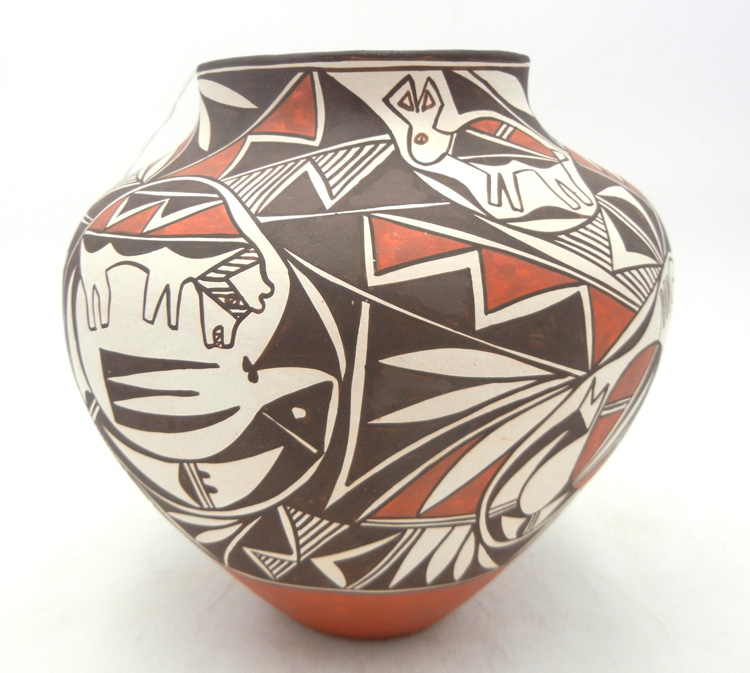Acoma pottery is celebrated for its unique beauty, intricate designs, and cultural significance. These beautiful pieces come from the Acoma Pueblo, known as “Sky City,” and are excellent adornments to any living space.
At Palms Trading Company, we offer authentic Acoma pottery for sale bought directly from local Acoma artists.
Below, we’ve explained where Acoma pottery comes from, what it was used for, and what makes it a true masterpiece of Native American craftsmanship.
Where is Acoma?
The Acoma Pueblo is located about 72 miles west of Albuquerque, New Mexico. It’s home to one of the oldest Indigenous communities in North America.
The Acoma tribe has been creating pottery for generations, and documentation of this beautiful art form dates back to 1150 AD. Their pottery has evolved into a symbol of their identity and connection to their ancestral homeland.
Each custom piece of Acoma pottery carries with it the stories, traditions, and spirituality of the Acoma people.
The techniques used for its creation and its distinctive decorative elements make it one of the most widely known and popular Indigenous North American pottery types.
What was vintage Acoma Pueblo pottery used for?
Originally, Acoma Pueblo tribal pottery was created for specific functional purposes. Large pots were used for cooking, and jugs were crafted to hold water on long trips. Seed jars and pottery bowls were used for storage. For ceremonial purposes, the Acoma created effigy pots.
Pieces were hand-painted and glazed.
However, in the late 1600s, following the Pueblo Revolt, limited access to mining sites made finding the correct glazing minerals challenging. Because of this, the decorative elements of Acoma pottery often took on a more unique, natural matte-like finish.
With the rise of new technologies in the early 20th century, traditional hand pottery crafting became less common amongst the Pueblo tribes. Acoma’s clay pieces became more widely crafted for aesthetic and decorative purposes.
Still, Acoma pottery techniques continued to be passed on by individuals credited for keeping the tradition alive.
Those individuals are often referred to as the Four Matriarchs of Acoma pottery — Marie Z. Chino, Lucy Lewis, Jessie Garcia, and Juana Leno. They maintained the traditional methods of collecting clay, shaping, carving, and firing with extraordinary care.
How were ancient pottery pieces created?
Traditional Acoma pottery uses natural materials such as local clay, which is found around the Acoma Pueblo region. The unique clay used is extremely strong even after the firing process, allowing pottery pieces to maintain thin walls and rims that are often fluted.
The traditional crafting method of Acoma pottery is hand coiling. This process involves creating long, snake-like clay ropes and coiling them vertically on top of themselves. A flat shell or rock is then used to smooth the surface.
These handmade pieces are pigmented using clay slips and are traditionally fired through an open fire pit or traditional kiln.
One of the most striking features of Acoma pottery is its traditional colors of white-on-white or black-on-white design, as well as polychrome pieces including reds and oranges.
This distinctive pottery style uses white or cream-colored clay and intricate geometric patterns painted with black mineral paint. Modern clay pieces feature various colors, such as shades of orange and neutral tones.
At Palms Trading Company, we carry these vintage treasures along with modern Acoma designs to satisfy your decorative needs.
What distinctive symbols are used with Acoma pottery?
Acoma pottery is renowned for its intricate geometric designs, which are visually captivating and hold deep cultural and spiritual significance.
Hatching patterns are lines used to symbolize environmental elements such as rain. Other designs allude to things like flowers or plants.
Elements such as birds or weather features like clouds and lightning are also commonly depicted. Spirals and swirls can represent the life-giving properties of water and wind, essential elements in the arid Southwest.
These mystical symbols are what make Acoma pottery so intriguing.
Where To Discover Exquisite Acoma Pottery
At Palms Trading Company, we have a wide variety of beautiful Acoma pottery created by well-known Acoma potters. Acoma pottery is a prized addition to any collection, and each piece tells a story of the artist’s skill and their rich cultural heritage.
For those who aren’t sure what they’re looking for online, we have an excellent personal shopper service to help you find the perfect piece. Our friendly staff at our local Albuquerque location can also help recommend pieces for your home.
Shop the splendor of Acoma pottery at Palms Trading Company and elevate your collection today!



